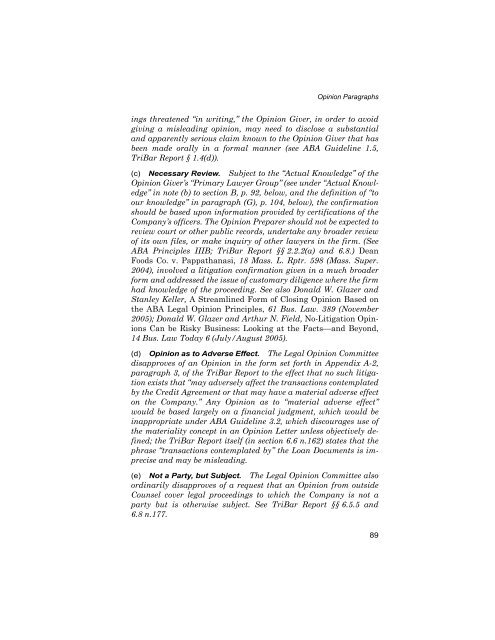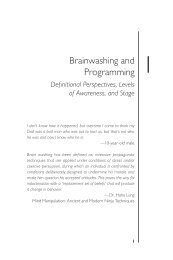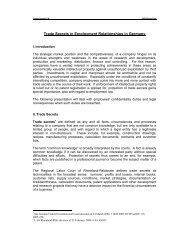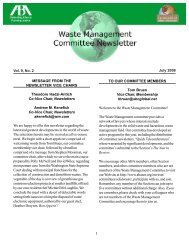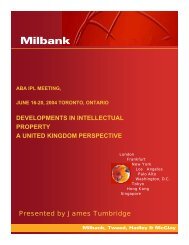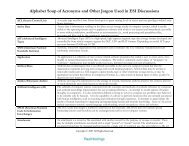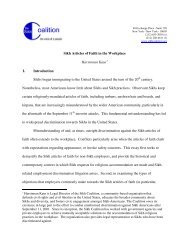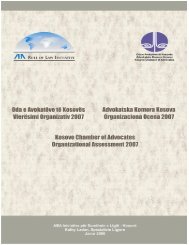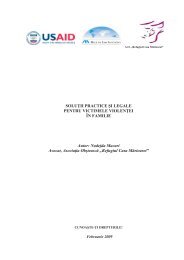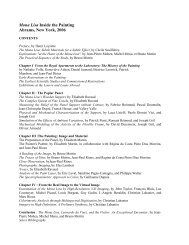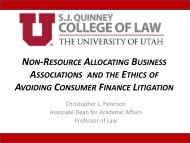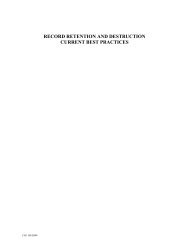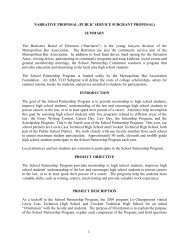Model Closing Opinion Letter (Annotated) - American Bar Association
Model Closing Opinion Letter (Annotated) - American Bar Association
Model Closing Opinion Letter (Annotated) - American Bar Association
You also want an ePaper? Increase the reach of your titles
YUMPU automatically turns print PDFs into web optimized ePapers that Google loves.
<strong>Opinion</strong> Paragraphs<br />
ings threatened “in writing,” the <strong>Opinion</strong> Giver, in order to avoid<br />
giving a misleading opinion, may need to disclose a substantial<br />
and apparently serious claim known to the <strong>Opinion</strong> Giver that has<br />
been made orally in a formal manner (see ABA Guideline 1.5,<br />
Tri<strong>Bar</strong> Report § 1.4(d)).<br />
(c) Necessary Review. Subject to the “Actual Knowledge” of the<br />
<strong>Opinion</strong> Giver’s “Primary Lawyer Group” (see under “Actual Knowledge”<br />
in note (b) to section B, p. 92, below, and the definition of “to<br />
our knowledge” in paragraph (G), p. 104, below), the confirmation<br />
should be based upon information provided by certifications of the<br />
Company’s officers. The <strong>Opinion</strong> Preparer should not be expected to<br />
review court or other public records, undertake any broader review<br />
of its own files, or make inquiry of other lawyers in the firm. (See<br />
ABA Principles IIIB; Tri<strong>Bar</strong> Report §§ 2.2.2(a) and 6.8.) Dean<br />
Foods Co. v. Pappathanasi, 18 Mass. L. Rptr. 598 (Mass. Super.<br />
2004), involved a litigation confirmation given in a much broader<br />
form and addressed the issue of customary diligence where the firm<br />
had knowledge of the proceeding. See also Donald W. Glazer and<br />
Stanley Keller, A Streamlined Form of <strong>Closing</strong> <strong>Opinion</strong> Based on<br />
the ABA Legal <strong>Opinion</strong> Principles, 61 Bus. Law. 389 (November<br />
2005); Donald W. Glazer and Arthur N. Field, No-Litigation <strong>Opinion</strong>s<br />
Can be Risky Business: Looking at the Facts—and Beyond,<br />
14 Bus. Law Today 6 (July/August 2005).<br />
(d) <strong>Opinion</strong> as to Adverse Effect. The Legal <strong>Opinion</strong> Committee<br />
disapproves of an <strong>Opinion</strong> in the form set forth in Appendix A-2,<br />
paragraph 3, of the Tri<strong>Bar</strong> Report to the effect that no such litigation<br />
exists that “may adversely affect the transactions contemplated<br />
by the Credit Agreement or that may have a material adverse effect<br />
on the Company.” Any <strong>Opinion</strong> as to “material adverse effect”<br />
would be based largely on a financial judgment, which would be<br />
inappropriate under ABA Guideline 3.2, which discourages use of<br />
the materiality concept in an <strong>Opinion</strong> <strong>Letter</strong> unless objectively defined;<br />
the Tri<strong>Bar</strong> Report itself (in section 6.6 n.162) states that the<br />
phrase “transactions contemplated by” the Loan Documents is imprecise<br />
and may be misleading.<br />
(e) Not a Party, but Subject. The Legal <strong>Opinion</strong> Committee also<br />
ordinarily disapproves of a request that an <strong>Opinion</strong> from outside<br />
Counsel cover legal proceedings to which the Company is not a<br />
party but is otherwise subject. See Tri<strong>Bar</strong> Report §§ 6.5.5 and<br />
6.8 n.177.<br />
89


